Top 5 Makita Tools Every Home Workshop Needs
MAKITA GENERAL
10/15/202519 min read


Introduction to Makita Tools
Makita Corporation, a Japanese multinational company, has long established itself as a leader in the power tool industry. Founded in 1915 as a manufacturer of electric motors, Makita began producing power tools in 1958, quickly gaining a reputation for quality and durability. Over the decades, the brand has expanded its product line to include a wide array of tools catering to various applications, from woodworking to construction, thus solidifying its standing among professionals and DIY enthusiasts alike.
The brand's commitment to innovation plays a significant role in its consistent success. Makita is renowned for developing advanced technologies that enhance the performance and efficiency of its power tools. For instance, the introduction of lithium-ion battery technology revolutionized the cordless power tool market, allowing users to enjoy longer run times and reduced charging intervals. Such advancements ensure that Makita tools remain at the forefront of industry standards, providing users with the reliability necessary for demanding tasks in their home workshops.
Reliability is another hallmark of Makita tools, which are engineered to meet the rigorous demands of various users. With a focus on meticulous manufacturing processes and comprehensive testing, Makita guarantees that each tool can withstand heavy use while delivering consistent performance. This reliability has fostered a loyal customer base where many professionals trust only Makita for their essential tool needs. Furthermore, their tools are designed with user-friendliness in mind, allowing both amateurs and seasoned tradespeople to operate them with ease.
In light of this reputation for quality, innovation, and reliability, selecting the right tools from Makita can significantly enhance one's home workshop experience. The comprehensive range of options ensures that there is a tool available for every need, making it an essential brand for anyone looking to undertake projects at home.
Essential Makita Tools for Every Home Workshop
Disclosure: This post contains affiliate links. If you click and make a purchase, I may earn a small commission at no extra cost to you.
Makita XSH03Z 18V LXT® Lithium-Ion Brushless Cordless 6-1/2" Circular Saw
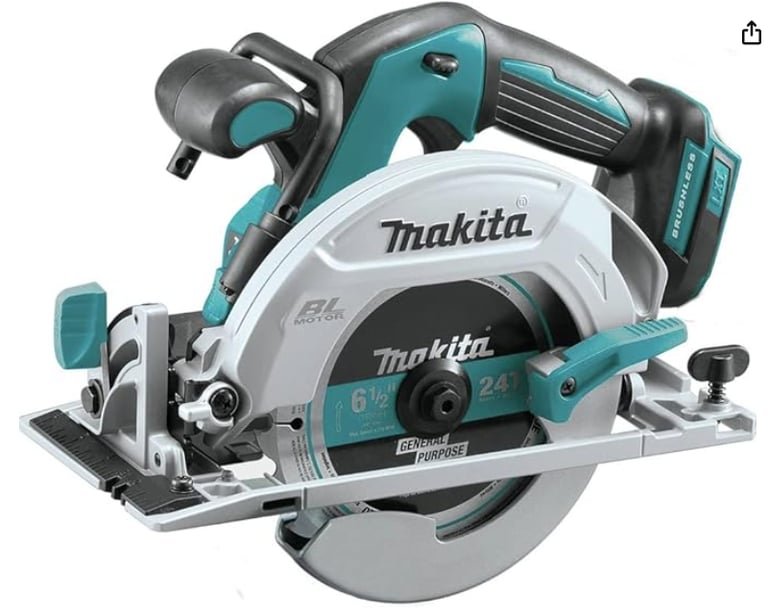

Click 'Shop Now!' to find on Amazon now...
🛠️ Specification
The Makita XSH03Z is a cordless circular saw powered by the Makita 18V LXT lithium‑ion battery platform (battery and charger are sold separately in the “tool only” version). It uses a brushless motor capable of delivering around 5,000 RPM no‑load speed, which allows fast cutting and ripping through wood. The saw accepts a 6‑1/2‑inch blade with a 5/8‑inch arbor.
Regarding cutting capacity, it can cut about 2‑1/4 inches deep at 90 degrees, about 1‑5/8 inches at 45 degrees, and somewhat less (≈1‑7/16 inch) around 50 degrees. It supports bevel cuts up to 50°, with a positive stop at 45° and fine adjustment options. The tool’s length is approximately 13‑3/4 inches, making it relatively compact for its blade size. When equipped with a compatible battery, its net weight is about 7.3 pounds, which puts it in a manageable range for home‑workshop use without being overly bulky.
Other features include a heavy‑gauge, precision‑machined base (shoe), built‑in dust blower to help clear sawdust from the cutting line, dual LED lights to improve visibility of the line, a rubberized soft‑grip handle for comfort, an electric brake to stop the blade quickly, and Makita’s protection systems (for battery overload, overheating, etc.). It also includes “Automatic Speed Change” technology, which modulates speed and torque depending on load to improve performance and battery efficiency. The construction is rugged, with die‑cast magnesium parts for the base and guard, plus Makita’s Extreme Protection Technology (XPT) for improved resistance to dust and moisture in harsher environments.
✅ Advantages and Disadvantages
Advantages:
Strong performance: The 5,000 RPM brushless motor, combined with the 6½‑inch blade, gives solid power for ripping boards, cross‑cutting, and general woodworking tasks. It cuts through typical lumber smoothly and doesn’t stall under moderate load.
Good cutting capacity and bevel range: Deep enough cuts at common angles (90°, 45°) for many home projects, joinery, cabinetry, furniture parts etc. The 50° bevel option expands versatility.
Portability and convenience: Being cordless means you’re not limited by an extension cord. It’s lighter than many corded saws of similar capacity, so moving it around a small workshop is easier. Features like the electric brake, LED lights, dust blower help usability.
Durability and protection: Magnesium shoe, guards, XPT for dust/water resistance, and protection electronics extend tool life, especially in a workshop where conditions may include sawdust, occasional moisture etc.
Ergonomics: Soft grip handle, balanced design, and relatively compact length help reduce fatigue, especially for handheld or jobsite‑style uses.
Disadvantages:
Battery and charger not included: If you don’t already have Makita 18V batteries, initial cost is higher because you need to invest in battery packs and charger separately.
6½‑inch blade limits depth: For very thick stock (e.g. thick beams, large timbers, trimming thick boards) or for tasks that need deeper cuts, larger blade saws or table saws will outperform it.
Weight under load: Although 7.3 lbs is reasonable, with battery attached and during extended use or for overhead or awkward angle cuts, fatigue can still become significant.
Dust control needed: Built‑in blower helps, but sawdust is still thrown around; without good dust extraction or frequent cleaning, visibility and air quality suffer.
Precision finish limitations: While very good, finish on plywood or laminated panels can sometimes show tear‑out unless using a high‑quality blade. For ultra‑fine work or cabinetry, further sanding or finishing passes may be required.
🔍 Our Review
In our home workshop use, the Makita XSH03Z has performed admirably across many different woodworking tasks. For example, trimming plywood sheets, cross‑cutting fence boards, and cutting hardwood for smaller projects (shelves, frames, etc.). We appreciate how quickly the blade gets up to speed and how the saw maintains power even when pushed (thicker wood, dense grain). The Automatic Speed Change functionality makes a difference — it detects resistance and adjusts, so you get smoother cuts and less chance of bogging down.
Ergonomically, the soft grip handle and lighter weight help with control, especially on longer cuts. The LED lights are really helpful in dim workshop corners to follow lines accurately; the dust blower is useful, although not a replacement for a vacuum or external extraction. The electric brake improves safety and speed of use between cuts.
On the downside, using it continuously on long cuts or thick stock tends to drain the battery fast, so having spare batteries is almost mandatory. Also, when pushing it for fine‑finished parts, some tear‑out occurs on higher grade plywood or laminated boards if the blade isn’t optimal. We also noticed that bevel adjustments feel good, but aligning exactly can take a bit of time to get accurate angles. Overall, though, it’s become one of our more used saws in the shop — reliable, powerful, and versatile for many home projects.
🗣️ Other Customers’ Reviews
Many users praise this saw for its excellent power in a portable cordless format. Comments frequently mention how cleanly it cuts through flooring material, plywood, and boards, and that it holds up well under repeated use. People who already own Makita’s battery ecosystem often say this saw slots in nicely and is worth the investment because they can use existing batteries. The speed, torque, and durability are often highlighted as strong points.
On the critical side, some users express disappointment that the saw doesn’t come with a battery or charger — meaning extra initial cost. Others comment that performance drops when using smaller battery packs — lower amp‑hour ones; the saw feels less powerful or cuts more slowly under thicker load with such packs. A few reviews mention the blade quality that comes stock isn’t always suitable for fine finish; many prefer upgrading the blade for clean cuts. Some also say that for very long cuts, the saw drifts if the workpiece or support isn’t well arranged, so guides or stable sawing tables are preferred. Overall, the consensus is that this is a top‑tier tool for a home workshop, especially for anyone wanting a reliable, cordless saw for a variety of wood tasks — so long as you expect to spend a bit extra on batteries and blades.
Makita XFD13 18V 1/2" Brushless Drill Driver

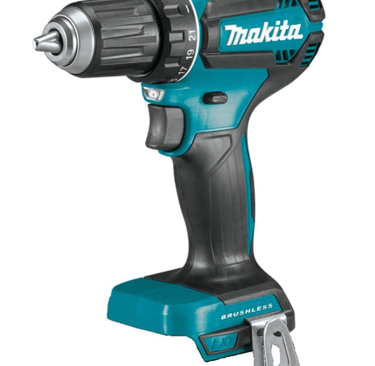
Click 'Shop Now!' to find on Amazon now...
🛠️ Specification
The Makita XFD13 is a cordless drill/driver in Makita’s 18V LXT range. It features a brushless motor, which provides higher efficiency, longer runtime, and less maintenance compared to brushed motors. It delivers about 480 in-lb (inch-pounds) of torque in its high setting and lower torque in its first gear, providing flexibility for both drilling and screw driving tasks.
It has a two-speed gearbox, with the low speed mode (for control and driving) and a high speed mode (for faster drilling). The no-load speeds are approximately 0–600 RPM in low speed and 0–1,900 RPM in high speed. The chuck is a ½‑inch metal, keyless style, compatible with a wide variety of bits. The tool offers a 21-position clutch to fine-tune torque for delicate tasks (e.g. cabinetry hardware, trim) and reduce the risk of stripping screws.
In terms of ergonomics, the XFD13 is fairly compact and balanced. Without the battery, its weight is modest (often in the ballpark of 3 lbs or so, depending on version), making it comfortable for extended use. It includes a built-in LED light beneath the chuck to illuminate work surfaces. The drill has a rubberized grip for better hold and reduced slipping. It is compatible with Makita’s 18V LXT battery platform, meaning existing batteries and chargers in that ecosystem can be used.
✅ Advantages and Disadvantages
Advantages (for a home workshop):
Versatility: With its torque, clutch settings, and two-speed transmission, it can handle a broad range of tasks—from drilling pilot holes, driving screws into hardwoods, to lighter hammering or mixing with appropriate attachments.
Brushless Efficiency: A brushless motor means less energy loss, longer battery life, and better performance under load—helpful for sustained workshop use.
Fine Control: The 21-position clutch gives good user control, helping prevent screw stripping or damage to materials, especially when working with delicate woods or finishes.
Lightweight & Comfortable: The balance and grip make it more comfortable in your hand than many heavier drills, reducing fatigue over multi-hour workshop sessions.
Ecosystem Compatibility: If you already have Makita 18V batteries, you save on cost and enjoy interoperability with other tools in your shop.
Disadvantages:
Torque Limitations: Although fine for many woodworking tasks, it’s not a heavy-duty driver—very thick lag screws or deep boring might push it to its limits. For very tough tasks you might find a more powerful driver or impact tool preferable.
Battery Weight: When you attach a full-capacity battery, the total weight increases significantly, which can make overhead or awkward-angle use more tiring.
Speed Trade-offs: While 1,900 RPM is good for drilling, for larger bits or heavy materials you might experience some lag or choppiness if you push it hard.
LED Brightness: The built-in LED helps, but in very dark workshops or deep cavities it may not be sufficient; additional lighting might still be needed.
Plastic Parts: Some external parts (e.g. casing, bit-lock collars) are plastic and may show wear or stress over time in a busy workshop.
🔍 Our Review
In our home workshop, the Makita XFD13 has become one of the go-to drills for general woodworking tasks. When building projects like cabinets, shelves, jigs, and small furniture, it handles pilot drilling, screw driving, and even reaming tasks well. The clutch helps especially when installing hardware or working near edges, reducing the risk of splitting wood or camming out screws. The brushless motor shows its worth when doing repetitive tasks: bit after bit, the performance stays solid, and it doesn’t heat up excessively.
We appreciate its ergonomic design; it feels balanced with a mid-size battery and less fatiguing than many drills in its class. The LED is useful for quick inside-cabinet or low-light work, although we still keep a shop headlamp for extra brightness. One limitation we hit is in driving long lag bolts or large-diameter fasteners into thick hardwood; it’ll manage, but slowly and with noticeable stress. Also, precision drilling with large bits or countersinking sometimes requires backing off speed or supporting the work well to avoid drift. But in day-to-day use, it is very reliable, efficient, and well suited for a home woodworking environment.
🗣️ Other Customers’ Reviews
Users often praise this Makita drill for its balance of power, control, and comfort. Many shop owners or home‑woodworkers note that it drills smoothly and drives screws cleanly, especially in hardwoods or cabinet-grade plywood. The clutch settings are frequently called out as a major benefit—especially useful when drivers toggle between coarse screwing and more delicate trim work.
Some critiques include comments on the battery weight making it heavier in long use, especially for overhead or tight angle tasks. A few users mention that when using larger bits, the drill slows a bit or takes hand support. Some also comment that while the LED is helpful, it isn’t a full replacement for additional lighting in darker corners. Others mention occasional minor cosmetic wear on plastic parts or casing when used heavily over time. Overall, the consensus is very favorable: it’s viewed as a dependable, well-rounded tool for a home workshop that handles most tasks without needing a full lineup of specialty drills.
Makita XOB01Z 18V LXT® Lithium-Ion Cordless
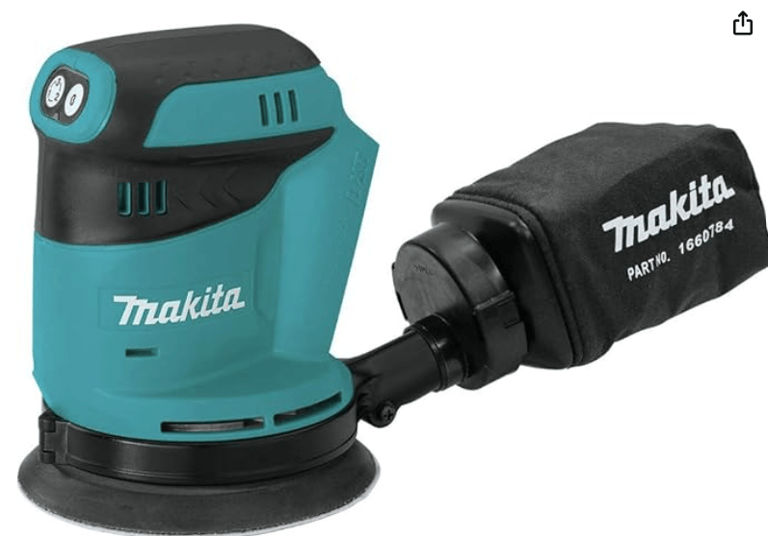

Click 'Shop Now!' to find on Amazon now...
🛠️ Specification
The Makita XOB01Z is a cordless 5-inch random orbital sander powered by Makita’s 18V LXT lithium-ion battery system. It features a brushless motor that delivers three speed settings: 7,000, 9,500, and 11,000 orbits per minute (OPM), allowing users to match the speed to the application. The sanding pad is 5 inches in diameter and uses a standard 8-hole hook-and-loop design for quick sandpaper changes.
This sander includes a pad brake to reduce free-spin and a pad control system that ensures smooth startup. The orbit diameter is 1/8 inch, offering a good balance between aggressive material removal and fine finishing. The built-in dust collection system channels dust through the sanding pad into an attached fabric dust bag, though it can also be connected to a vacuum system using a compatible adapter. The unit weighs around 3.6 pounds with a battery, making it lightweight and maneuverable for handheld use.
✅ Advantages and Disadvantages
Advantages:
Cordless Convenience: No cords to trip over or limit movement, which is especially handy in smaller workshops or when sanding large pieces like tabletops or cabinet panels.
Three-Speed Settings: Offers good control over material removal and finish quality, giving you flexibility to work on softwoods, hardwoods, or delicate veneers.
Efficient Dust Collection: Through-the-pad dust extraction and included dust bag reduce airborne particles, helping maintain a cleaner work area.
Good Ergonomics: Compact, lightweight design with a comfortable grip reduces fatigue during long sanding sessions.
Durability: Dust-sealed switch and bearings extend tool life in workshop conditions where sawdust is everywhere.
Disadvantages:
Battery Runtime Limits: With a smaller battery, run time may be short, especially on higher speed settings. For longer jobs, you’ll need a spare battery or high-capacity pack.
Not for Heavy Stock Removal: While effective for most sanding tasks, it’s not ideal for aggressive removal of thick finishes or leveling very rough surfaces.
Pad and Disc Wear: As with any sander, you'll need to replace the sanding pad and discs periodically—especially with heavy use.
Dust Bag Capacity: The small dust bag fills quickly, so frequent emptying or switching to a vacuum setup is needed for larger jobs.
🔍 Our Review
In our home workshop, the Makita XOB01Z quickly became a favorite tool for finishing tasks. Whether we were smoothing down pine furniture frames, sanding plywood shelves, or prepping reclaimed wood for stain, this sander proved powerful enough for most jobs. The three-speed settings were genuinely useful: low speed for delicate work, high speed for efficient sanding.
Its cordless design made it incredibly convenient. Being able to move around the shop—or even work outdoors—without dragging a cord behind is a real improvement. Dust collection was decent with the included bag, but vastly better when connected to a small shop vac. Ergonomically, it’s easy to hold and control, even during longer sessions.
The only real downsides we encountered were battery-related. Using a 2.0Ah battery, we got about 20–25 minutes of steady sanding before needing a charge. A higher-capacity battery stretched that closer to 40 minutes. Still, having two batteries on hand solved that problem. For extremely rough boards, it wasn’t as aggressive as a belt sander or corded model, but it got the job done with patience.
Overall, it’s a great addition to any home workshop—quiet, effective, and easy to use.
🗣️ Other Customers’ Reviews
Other users often praise the XOB01Z for its portability and performance. Many homeowners and hobbyists find it ideal for refinishing furniture, sanding cabinetry, or preparing wood for painting or staining. The three-speed settings get frequent mention as a standout feature, giving more control than single-speed models.
Battery life is the most common concern, especially when using smaller packs. However, most users agree that the trade-off is worth it for the freedom of movement it offers. Some also note that the dust bag, while helpful, doesn't always capture everything, and pairing it with a vacuum is the way to go.
In general, the XOB01Z is seen as a reliable, efficient cordless sander that’s well-suited to the demands of a home workshop, especially for users already invested in Makita’s 18V tool ecosystem.
Makita XPK02Z 18V LXT® Lithium-Ion Brushless Cordless 3-1/4" Planer
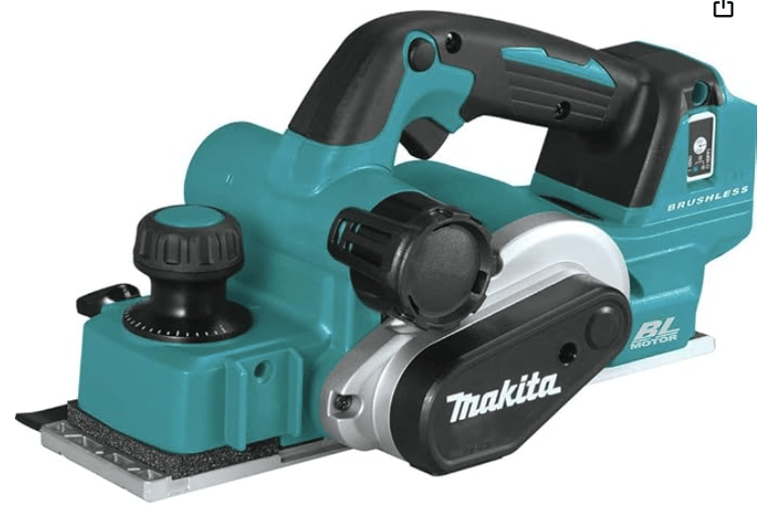

Click 'Shop Now!' to find on Amazon now...
🛠️ Specification
The Makita XPK02Z is a cordless planer designed to run on Makita’s 18V LXT lithium-ion battery system. It features a brushless motor that delivers up to 12,000 RPM for fast, efficient stock removal. The planer can cut up to 3-1/4 inches wide and up to 1/8 inch deep in a single pass, with a maximum rabbeting depth of approximately 1 inch.
It comes with a precision-machined aluminum base for flat, accurate planing and includes three machined chamfering grooves for edge beveling. The depth of cut is adjustable via a large front knob, allowing precise settings in increments of 1/256 inch. This model also features dual-direction chip ejection, so you can choose which side to eject chips from based on your workspace setup. It has a spring-loaded kickstand to protect both the blades and work surfaces when the tool is at rest. The planer weighs roughly 6.5 to 7.5 pounds with battery installed, making it manageable for handheld use.
✅ Advantages and Disadvantages
Advantages:
Cordless convenience: Makes planing more mobile and less restricted, especially when working on long boards or outside the shop.
Brushless motor: Offers better efficiency, cooler operation, and longer tool life with more consistent performance.
Accurate depth adjustment: Lets you fine-tune your cuts, which is great for cabinetry, trimming, or fitting work.
Wide planing capacity: At 3-1/4 inches, it can cover most home woodworking tasks without needing multiple narrow passes.
Dual chip ejection: Helps manage dust and debris based on your working position or handedness.
Kickstand: Protects the blades and your project surface when you set the tool down.
AWS Capable: Can be paired with Makita's Auto-Start Wireless System for automatic dust control (if you own the compatible system).
Disadvantages:
Battery runtime limitations: Heavier use on harder woods or deeper cuts can drain batteries quickly, especially with lower amp-hour models.
Tool weight: While balanced, it’s still a bit heavy for extended overhead or vertical use.
Not for heavy-duty planing: For large timber stock removal, a benchtop or corded planer would be faster and more consistent.
Blade maintenance: Requires sharp blades for a clean finish, and dull blades can lead to surface tear-out or rough passes.
AWS extra cost: To benefit from the Auto-Start dust control system, you need additional accessories not included with the tool.
🔍 Our Review
In our experience, the Makita XPK02Z is an excellent tool for a home workshop that values mobility, precision, and build quality. It handled everything from trimming door edges to cleaning up reclaimed wood boards with ease. The brushless motor gives the tool a solid feel during use — it doesn’t bog down under typical workloads, and the results were consistently smooth.
The depth control is intuitive and accurate, letting us make micro adjustments when planing to fit or when we needed a clean, even shave. We also appreciated the dual chip ejection, which kept our workspace cleaner and allowed us to avoid blowing debris in our face or onto other tools.
One area where it really shines is finish work — the planer leaves a surprisingly smooth surface when used with sharp blades. However, we did notice that for long sessions, especially on harder woods, battery life became a concern unless using a higher capacity battery. Weight was manageable, though after repeated use it does become tiring if you're doing lots of edge planing in one go.
Overall, this is a great cordless planer that adds versatility and efficiency to a small or medium home workshop, especially for woodworkers who already own Makita 18V tools.
🗣️ Other Customers’ Review
Many users who own the Makita XPK02Z praise it for its performance and precision. It’s often described as ideal for door trimming, furniture work, and smaller carpentry projects. The ease of cordless use is frequently mentioned as a game changer, especially by those who move between indoor and outdoor work areas or don’t have a dedicated workbench.
Common compliments include the planer’s smooth operation, consistent cutting depth, and overall build quality. Users appreciate the ability to adjust chip ejection to avoid making a mess, and they value the tool’s quick, precise setup.
However, some users do express concerns about battery life during extended or intensive planing tasks. A few also note that the planer is slightly heavier than they expected, which can lead to hand fatigue during longer jobs. In terms of dust collection, most agree it works well with a vacuum but that the included bag fills quickly.
Makita XFD14Z 18V LXT® Lithium-Ion Brushless Cordless 1/2" Driver-Drill
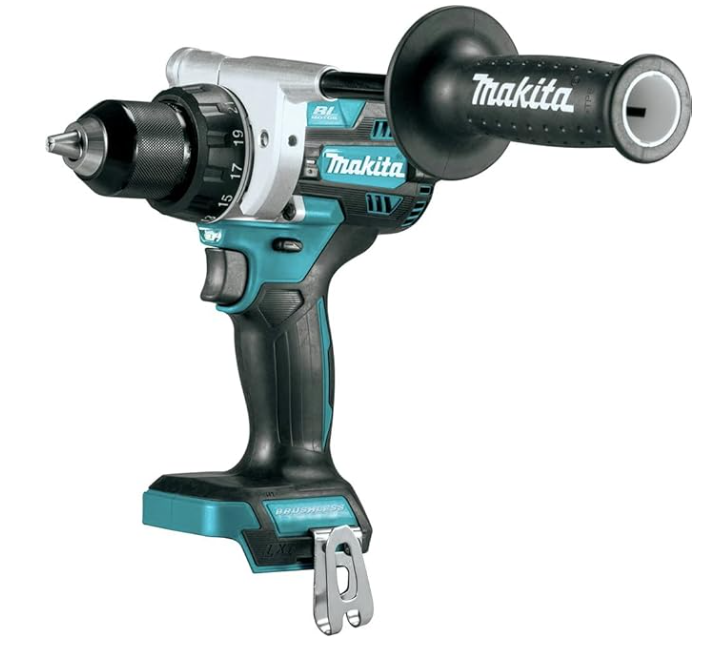

Click 'Shop Now!' to find on Amazon now...
🛠️ Specification
The Makita XFD14Z is a compact and powerful 18V cordless driver-drill designed for professional performance in a smaller package. It uses Makita’s 18V LXT lithium-ion battery platform (batteries and charger typically sold separately) and is equipped with a brushless motor that delivers up to 2,000 RPM and 530 in-lbs of maximum torque.
The drill features a 2-speed transmission (0-500 RPM on low and 0-2,000 RPM on high), offering versatility for both high-speed drilling and high-torque driving tasks. It has a 1/2-inch metal ratcheting chuck for better bit retention and durability. The tool’s weight is approximately 3.6 pounds with a battery, making it suitable for prolonged use without fatigue. It also includes a built-in LED light to illuminate the workspace and a variable-speed trigger for added control. The brushless motor is electronically controlled to optimize battery usage and reduce heat buildup.
✅ Advantages and Disadvantages
Advantages:
Brushless Motor: Efficient and longer-lasting, giving more power output while consuming less battery. Ideal for regular home workshop use.
High Torque & Dual-Speed Gearbox: Offers flexibility between high-speed drilling and slower, high-torque driving. Useful for both softwoods and hardwoods.
Compact & Lightweight: Easy to maneuver and comfortable for overhead or extended tasks without excessive fatigue.
Durable Build: Metal chuck and solid housing stand up to workshop abuse, offering reliability even with frequent use.
Good Battery Compatibility: Compatible with the full Makita 18V LXT line, so it integrates easily into existing tool systems.
LED Work Light: Illuminates dark areas, which is useful in garages, under cabinets, or tight corners.
Disadvantages:
Tool-Only Configuration: Batteries and charger are sold separately, which adds to the initial cost if you’re not already in the Makita ecosystem.
Not Ideal for Heavy-Duty Masonry: It can handle light concrete drilling with the right bit, but it's not a dedicated hammer drill.
No Onboard Bit Storage: While minor, some users may miss having a convenient place to store driver bits directly on the tool.
Trigger Sensitivity: Some users may find the variable-speed trigger a bit touchy, requiring a light touch for low-speed control.
🔍 Our Review
In our home workshop, the Makita XFD14Z has quickly proven itself as a go-to tool for everyday drilling and fastening jobs. Whether assembling furniture, installing shelves, or working on light carpentry projects, it’s fast, dependable, and well-balanced.
What stands out most is the motor performance — the brushless design really does run cooler and more efficiently. Battery life is excellent, especially when paired with a 4.0Ah or 5.0Ah battery. The high torque is more than enough for driving long screws or drilling into dense wood, and the two-speed gearbox helps adjust performance depending on the material.
The metal chuck feels solid and holds bits tightly, even under torque. We also appreciated the ergonomic grip and relatively low weight, which helped with fatigue during longer sessions. The LED light was surprisingly useful in dim corners, especially during late-night projects in the garage.
Overall, the XFD14Z is a great addition to any home workshop. It brings pro-level features and build quality to DIYers, hobbyists, and weekend warriors who want a tool they can count on for years.
🗣️ Other Customers’ Review
Customers often describe the XFD14Z as a powerful, compact, and reliable drill for both professional and home use. Many appreciate the smooth power delivery and the comfortable grip, noting that it feels more robust than cheaper alternatives without being bulky.
Positive feedback frequently mentions the battery life and how well the drill holds up under pressure. Users like that it can handle everything from pilot holes to lag bolts without bogging down. The quietness and efficiency of the brushless motor also receive high marks.
Criticisms are usually minor — most complaints come from buyers who weren’t aware it’s a tool-only version, or from those wanting a bit more torque for heavier-duty tasks. Some mention the lack of magnetic bit storage, but that’s more of a convenience feature than a dealbreaker.
Overall, most users agree that if you're already using Makita’s battery platform, the XFD14Z is an excellent mid-to-high-performance drill that suits nearly every task you'd face in a home workshop.
Benefits of Using Makita Tools
Makita tools are renowned for their exceptional quality and reliability, making them an ideal choice for any home workshop. One of the primary benefits of using Makita tools is their durability. Constructed with premium materials, these tools are designed to withstand the rigors of frequent use. This quality ensures a longer lifespan, which is a significant advantage for homeowners engaged in various DIY projects. The efficiency gained from utilizing durable tools translates directly to savings in both time and money, as users do not need to frequently replace worn-out equipment.
User-friendly design is another hallmark of Makita tools. The tools are engineered with ergonomics in mind, which reduces fatigue during prolonged use. Features such as soft grips, lightweight constructions, and intuitive controls enhance usability, particularly for individuals who may not have professional experience. This accessibility encourages users to engage more confidently in their home improvement projects, thereby increasing productivity.
Safety cannot be overlooked when discussing the benefits of Makita tools. Many of their products incorporate advanced safety features that protect users during operation. For example, some models feature electric brakes and automatic shutdowns, which minimize the risk of accidents. This commitment to safety is vital, especially for homeowners who may not have extensive training in tool usage.
Additionally, the availability of various accessories enhances the versatility of Makita tools. Whether it is drill bits, blades, or specialized attachments, Makita provides a comprehensive range of compatible accessories tailored to meet diverse project needs. Testimonials from users consistently highlight how these tools and their accessories significantly improve efficiency and performance in their home workshops. By investing in Makita tools, homeowners can transform their spaces into productive work environments, making any building or renovation project more manageable and enjoyable.
Tips for Maintaining Your Makita Tools
To ensure the longevity and peak performance of your Makita tools, implementing a proper maintenance routine is essential. This involves several key practices that can significantly extend the life of your equipment while enhancing its functionality.
First and foremost, regular cleaning is crucial. After each use, it is advisable to remove any dust, debris, or sawdust from your tools. Utilizing a soft brush or a damp cloth can effectively clean the surfaces without causing damage. Special attention should be given to air vents and moving parts, as accumulated dirt can hinder performance and lead to overheating. For power tools, ensure that the batteries are also kept clean and free of corrosion. This basic upkeep will ensure that tools operate smoothly during future operations.
Storage practices also play a vital role in maintaining your Makita tools. Tools should be stored in a dry, cool environment to prevent rust and corrosion. If possible, use tool boxes or cabinets to protect them from dust and moisture. For frequently used items, organizing them in workshops or garages can enhance accessibility while ensuring they are protected from accidental damage.
Routine inspections are another critical aspect of tool maintenance. Regularly check for any signs of wear and tear, including frayed cords or cracked casings. Early detection of issues allows for prompt repairs, preventing minor problems from escalating into more significant concerns. Depending on the level of use, it may also be prudent to schedule professional servicing annually. Trained technicians can provide comprehensive maintenance checks and repairs, ensuring tools remain in optimal condition.
By adhering to these maintenance tips, you can significantly enhance the lifespan and efficiency of your Makita tools. Proper care not only preserves your investment but also ensures that your projects are completed effectively and safely.
